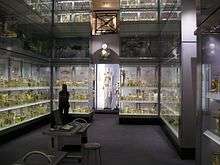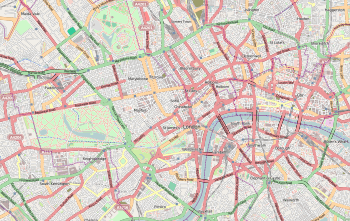Hunterian Museum (London)
The Hunterian Museum is a museum of anatomical specimens in London, located in the building of the Royal College of Surgeons of England.
 The skeleton of the 7 1⁄2-foot (2.3 m) tall "Irish Giant" is visible in the middle of the photo. | |
 Location within central London | |
| Established | 1799 |
|---|---|
| Location | Royal College of Surgeons of England, Lincoln's Inn Fields, London, England |
| Coordinates | 51°30′55″N 0°6′57″W |
| Collection size | approximately 3,500 specimens[1] |
| Visitors | 85,000 per year[2] |
| Public transit access | |
| Website | |
History
In 1799 the government purchased the collection of the Scottish surgeon John Hunter which they presented to the College. This formed the basis of the Hunterian Collection, which has since been supplemented by others including an Odontological Collection (curated by A E W Miles until the early 1990s) and the natural history collections of Richard Owen.
The first museum building was considered inadequate in terms of space, and was closed in April 1834 to allow for an expansion project which added additional East and West galleries, completed in February 1837. A third room was added in 1852, and two further galleries were added between 1888 and 1892.[1] In May 1941 the College building was badly damaged by bombs, with Rooms IV and V of the museum being completely destroyed along with their contents. After a slow process of entirely new construction in which some of the original design features were maintained, the Hunterian Museum reopened in a reduced form in 1963.[1][2]
Collections
The Hunterian Museum is a member of The London Museums of Health & Medicine group, and displays thousands of anatomical specimens, including the Evelyn tables, instruments belonging to Joseph Lister, and the skeleton of the "Irish giant" Charles Byrne, surgical equipment, and paintings and sculptures about medical individuals and medicine.[3][4] The museum's odontological collection includes teeth retrieved from soldiers at the battle of Waterloo, a necklace of human teeth brought to England by explorer Henry Morton Stanley, and a set of dentures belonging to Winston Churchill.[1]
The museum closed in May 2017 for renovation work, to reopen in May 2020.[2]
Gallery
.jpg) The skeleton of Charles Byrne (1761–1783)
The skeleton of Charles Byrne (1761–1783) Scyllarides latus, the slipper lobster
Scyllarides latus, the slipper lobster Skeleton of Dinornis novaezealandiae, the extinct North Island giant moa
Skeleton of Dinornis novaezealandiae, the extinct North Island giant moa A species of large toad dissected to show ripe ovaries and contracted oviducts
A species of large toad dissected to show ripe ovaries and contracted oviducts
References
- "History". Royal College of Surgeons.
- "Building On Our Heritage". Royal College of Surgeons.
- "Medical Museums". medicalmuseums.org. Retrieved 26 August 2016.
- "Collections". Hunterian Museum. Retrieved 11 November 2015.